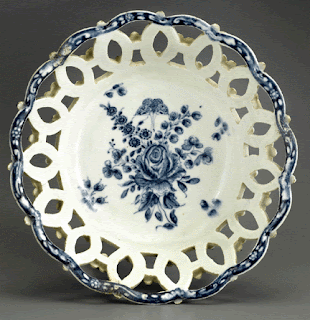(Cultural-China)
Bow Ware
The first soft-paste porcelaine in England that was made on a factory at Statford-le-Bow, East London, founded in 1744. It is made of white clay (kaolin) brought from North Carolina. A uch harder paste is has various colors like white and blue-grey tint with a thick greenish glaze.
(Wikimedia Commons, 2014), (RISD, 2015)
Chelsea Ware
The well-known "goat and bee" Chelsea 1745. It had a thick uneven body, each piece is applied unevenly but is ornamented heavily in French style. Nicholas Sprimont, the head of the company where this porcelain was made.
In 1758, the composition of this paste was altered by the additon of calcine bone ash. During those time Chelsea porcelain marked for its outstanding design that is produced by one factory only. One of the unique and most valued product was the chelsea "toys". In 1769, the factory was sold to William Duesbury, proprietor of the Derby factory, and from 1770 to 1784, it was known as Chelsea-Derby period.
(Perry, 2011)
Derby Ware
People usually prefers derby ware as a collection.
Jasper Ware
Fine, hard, unglazed white bisque made by Wedgwood and other potters was perfected about 1775.
It was made in various surface colors introduced about 1777, known as dip jasper, and in blue, colored clear through, called solid jasper, and white bas-relief was used in combination with different colors.
Jasper was used for making vases, medallions, plaques and many other articles. The smoothness and color of the background, the sharpness and translucency of the ornament are marked excellent by the collectors.
"It looks very hard yet so fine. You can clearly feel the smoothness just by
looking and without touching it." -Casas C.
Queen's Ware
Original cream-colored earthenware named for Queen Charlotte, wife of George III, who appointed him Queen's Potter in 1762. Wedgwood named the cream ware after Queen Charlotte when she ordered a complete table service of it.
It was when the Queen was so pleased after she was served a breakfast using the creamware.
Cream ware term applies to all light-colored English earthenware from about 1750 to the present time. Cream ware was perfected by Wedgwood.
"Queen's ware looks very elegant and the details on it makes it looks
so beautiful and more elegant." -Casas C.
Basalt Ware
A solid black stoneware of great hardness, unglazed, which takes its name from a black Egyptian rock.
Wedgwood's basalt is regarded as superior to others because he made his basalt ware from native clay,
ground ironstone, ocher, and oxide of manganese.
"Basalt ware looks very rigid and very hard but it's smoothness
makes it look so fragile." -Casas C.
Agate Ware
Earthenware made either solid or in surface decoration to resemble the veining of agate or other natural stones.
It is produced by layers of different colored clays twisted together and then cut transversely with wire.
The surface ware is splashed and grained on an ordinary cream body.
The former method was never made to the same extent as marbling on the surface.
"The surface looks very complex yet so beautiful. It shows a natural movement of
the colors applied and also it's flexibilty." -Casas C.
 |
WORCESTER
Founded in 1751. Its
history has been comparatively uneventful, but, alone of all the English
porcelain ventures of the 18th century. Worcester figures of the early period
are very uncommon. The best period of old Worcester china and the china richest
in decoration was that made from about 1760 to 1783, the so called Dr. Wall
period and the porcelain commands very high prices today. The salmon scale blue
ground was one of the` characteristics of that period, and the gilding was of
superlative quality. -CALAPE
|
 |
TRANSFER PRINTED POTTERY
Discovered by John
Sadler in 1754, a method of transferring a design to paper from an engraved
cooper plate coated with pigment and from the paper to the property, which was
then fired over glaze producing crude and impermanent lines. Same method was
used by Robert Hancock. -CALAPE
|
 |
STAFFORDSHIRE
This is a generic
term applying to the productions of many potteries in Stoke-on Trent. Beginning
with the 19th century Staffordshire productions were devoted largely to blue
transfer printed wares. At first the willow pattern was used extensively. -CALAPE
|
 |
WEDGWOOD WARE
From the name of its
creator Josiah Wedgwood is said to be one of the first men to unite art and
industry. At first he made the usual run of pottery products, but in 1762 he
produced a cream ware which not only improved upon the earlier product but was
to supplant salt-glaze ware and was to be copied ware and was to be copied by
other potters, as well, Black basalt ware, of which Wedgwood is said to have
been the inventor, was first produced in 1766 but the finest work in this ware
was not done until much later. Old Wedgwoord is considered to be the finest
pottery that England has ever produced in workmanship, design, material and
color. -CALAPE
|
 |
JASPERWARE
This fine, hard
unglazzed while bisque made by Wedgwood and other potters was perfected about
1775, it was made in various surface colors introduced about 1777, known as dip
jasper, and blue, colored clear through, called solid jasper, and white
bas-relief was used in combination with the different colors. -CALAPE
|
 |
QUEEN'S WARE
Original
cream-colored earthenware named for Queen Charlotte, wife of George III. About
1760 Wedgwood improved the then recently new cream ware and he presented to
Queen Charlotte of England a decorated breakfast service of his new product. -CALAPE
|
Sources:


























